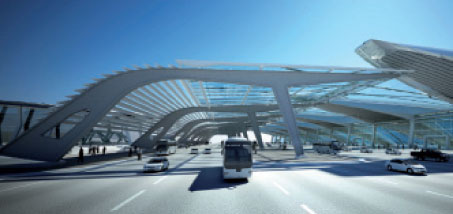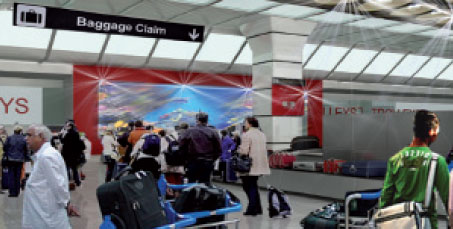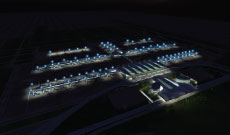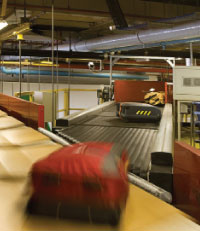
KLIA 2 is being constructed to replace the temporary Low-Cost Carrier Terminal, which was constructed in 2006.
Having established itself as one of Asia’s leading airports since opening in the summer of 1998, the multi-award-winning KLIA has enjoyed rapid passenger growth. In fact, in the first nine months of 2010, the airport handled 24.8 million passengers – a 17% year-on-year increase – with the low-cost sector enjoying growth of 18.5%.
In order to cater for this continued increase in demand, the temporary Low-Cost Carrier Terminal (LCCT) was constructed in 2006, but as it approaches its capacity of 15 million annual passengers, 2012 will see the introduction of the brand new, permanent facility.
Malaysia’s very own low-cost carrier, AirAsia, has grown in correlation with KLIA itself and the investment by Malaysia Airports Holdings Berhad (MAHB) is largely a direct result of the airline’s aggressive expansion.
“KLIA 2 is predominantly for AirAsia but we’re also open to the possibility of other low-cost airlines eventually operating from the facility,” said Mohamed Sallauddin bin Hj. Mat Sah, general manager marketing, Malaysia Airports. “It’s being constructed to cater for the expansion of AirAsia because by the end of next year, the existing LCCT will handle 15 million passengers.”
While KLIA 2 will cater for LCCs, Malaysia Airports insists that the terminal itself will be anything but low-cost. Tan Sri Bashir Ahmad, managing director, Malaysia Airports, explained: “The new low-cost terminal is only low-cost in terms of the construction, not the service that we offer to the airlines and the passengers.”
Sallauddin added: “We have a duty to our passengers, especially when you consider that the terminal will ultimately handle 30 million passengers per annum. It’s not a low-cost terminal, it’s a terminal that is being constructed for low-cost carriers.”
Once complete, KLIA 2 will cover an area of approximately 240,000sqm and of the 96 check-in counters, 44 will utilise self-check, while there will also be 28 bag-drop counters.
‘Next Generation Hub’
At the heart of Malaysia Airports’ five-year strategy up until 2014 is the desire for KLIA to be developed into the ‘Next Generation Hub’ – a hub airport which will allow for seamless connectivity between both low-cost and full-service carriers. In order to simplify this inter-carrier transfer, the airport authority has developed an online portal, allowing passengers to find the most convenient and affordable transfer options.
Sallauddin said: “Passengers already connect between the main terminal and the LCCT every day. Because of that we have seen the opportunity to be one of the first airports to formally embrace this market force. KLIA is an airport where the two categories of airlines are both growing constantly and as the airport we’re in the privileged position to cater to the needs of both low-cost and full-service carriers. We want to become an enabler and that’s why we’ve also created the portal. In a way, we’re empowering the passenger because we’re giving them the connection choice.”
Referring to the business plan, which is entitled ‘Runway to Success’, Ahmad explained: “Our strategy is based around three key areas. Firstly, we want to continue to grow the market and the traffic. Secondly, commercial development is very important because all airports now realise that more revenue must come from this source. Thirdly, we want to continue to enhance our service delivery to meet our high standards of service excellence.”

Sallauddin: “We have a duty to our passengers, especially when you consider that the terminal will ultimately handle 30 million passengers per annum.”
Network expansion
With construction work on the new KLIA 2 firmly underway, Malaysia Airports is now working with its airline partners to explore potential route expansion. While AirAsia already serves in excess of 50 destinations, its low-cost, long haul partner, AirAsia X, is also expanding its route portfolio with services to Paris being the latest addition.
Sallauddin explained: “For 2011 onwards, we’re looking at routes to Eastern and Central Europe where we’re lacking connectivity. We’re also looking at East and North Africa, where we’re constantly talking to airlines, but a lot depends on traffic rights so it takes time.”
In addition, he also outlined the ambition to introduce a direct link between the Malaysian capital and the US, admitting, however, that this “will not be easy”.
Commercial vision

Malaysia Airports’ five-year strategy up until 2014 outlines an ambition to establish KLIA as the ‘Next Generation Hub’ – a hub airport which will allow for seamless connectivity between both low-cost and full service carriers.
Having been identified as a key driver of revenue, Malaysia Airports has also developed a specific commercial strategy as it aims to increase the revenue share derived from non-aeronautical sources.
While revenue is currently distributed evenly between aeronautical and non-aeronautical streams, the aim is for the latter to account for as much as 70% in the near future. This commercial strategy is not exclusive to KLIA and Malaysia Airports will also apply it to the other 38 Malaysian airports in its extensive portfolio.
Four separate commercial models have been developed to suit the needs of the different airports and depending on the passenger profile, each airport’s commercial offering will be based on the either the Lifestyle, Leisure, Community, or Corporate Responsibility models.
Faizah Khairuddin, senior general manager, commercial, Malaysia Airports, explained: “A ‘one-size-fits-all’ approach really doesn’t apply and we have worked hard to establish this model, but the real challenge will be in the execution.”
With almost 50,000sqm of dedicated commercial and concession space, KLIA 2 will fall under the ‘Leisure’ heading. “KLIA 2 is very important to this and it will be the change platform,” Khairuddin explained. “We’re already very strong in corporate governance but we’re learning to take some calculated business risks in the commercial side of the business as well, which is why we’ve developed this growth strategy for the long-term.”
With KLIA 2 expected to become operational in 2012, and with a clear vision for both aeronautical and commercial expansion, Malaysia Airports’ vision is now to challenge and surpass its South East Asian counterparts. According to Sallauddin: “KLIA 2 will help to manifest Kuala Lumpur International Airport as the true Next Generation Hub.”
Crisplant’s Guangzhou contract
 Crisplant was awarded the €12.6 million contract to upgrade the automated baggage handling system at Guangzhou Baiyun International Airport in order to prepare the airport to handle visitors and athletes attending this year’s Asian Games.
Crisplant was awarded the €12.6 million contract to upgrade the automated baggage handling system at Guangzhou Baiyun International Airport in order to prepare the airport to handle visitors and athletes attending this year’s Asian Games.
Having designed and installed the original baggage handling system, the upgrade included the addition of 18 new check-in counters and conveyors and the integration of six new screening machines. The two original Crisplant tilt-tray sorters have also been extended with 10 inductions, while the sorting system upgrade included 11 vertical sort units, two chutes and 30 360° IATA tag scanners.
“The contract was awarded to Crisplant in October 2009 and all hardware – meaning check-in islands, inductions conveyors etc, as well as changes to the software was to be handed over in time for the Asian Games, which were held in November 2010,” explained Henrik Cort, sales manager, Crisplant.
This will now be followed by an upgrade of the baggage handling system software to the latest version of Crisplant high-level software – SAC (Sort Allocation Computer). “The new Sort Allocation Computer offers availability close to 100% and features multi-terminal capacity,” Cort said.
In order to meet the strict deadline, Crisplant carried out the upgrade with three daily work shifts and also worked closely with the airport’s operational department to minimise the impact on both the airport and the passengers.
Crisplant specialises in upgrading airports while in operation and other recent upgrade installations have been successfully completed in Changi Airport T2, Hong Kong International Airport, Johannesburg and Helsinki.







